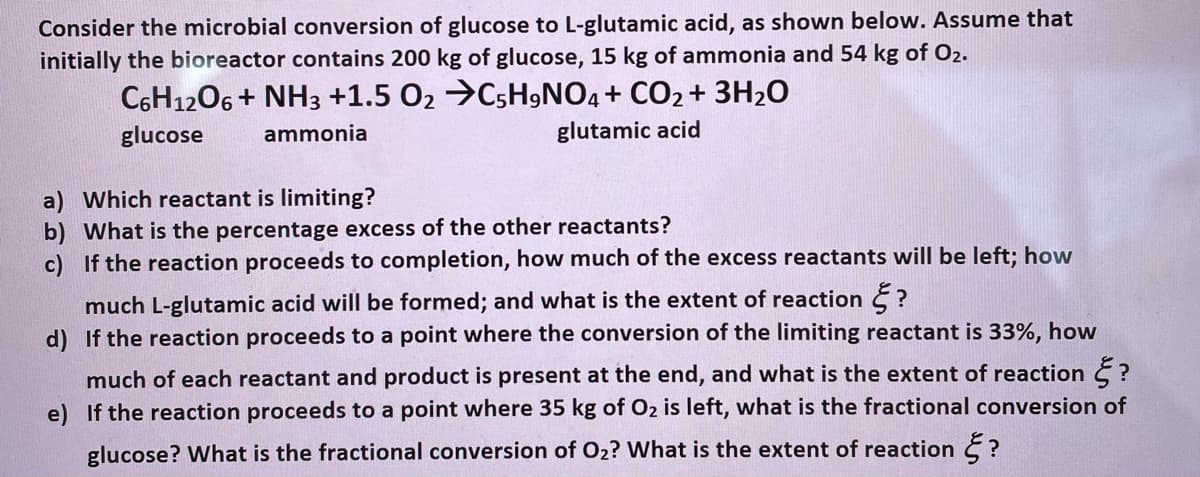Consider the microbial conversion of glucose to L-glutamic acid, as shown below. Assume that nitially the bioreactor contains 200 kg of glucose, 15 kg of ammonia and 54 kg of O2. C6H1206 + NH3 +1.5 O2 →CsH,NO4+ CO2+ 3H2O glucose ammonia glutamic acid a) Which reactant is limiting? b) What is the percentage excess of the other reactants? c) If the reaction proceeds to completion, how much of the excess reactants will be left; how much L-glutamic acid will be formed; and what is the extent of reaction ? nvorsion of the limiting re ctant is 33% how
Consider the microbial conversion of glucose to L-glutamic acid, as shown below. Assume that nitially the bioreactor contains 200 kg of glucose, 15 kg of ammonia and 54 kg of O2. C6H1206 + NH3 +1.5 O2 →CsH,NO4+ CO2+ 3H2O glucose ammonia glutamic acid a) Which reactant is limiting? b) What is the percentage excess of the other reactants? c) If the reaction proceeds to completion, how much of the excess reactants will be left; how much L-glutamic acid will be formed; and what is the extent of reaction ? nvorsion of the limiting re ctant is 33% how
Chemistry: The Molecular Science
5th Edition
ISBN:9781285199047
Author:John W. Moore, Conrad L. Stanitski
Publisher:John W. Moore, Conrad L. Stanitski
Chapter17: Electrochemistry And Its Applications
Section: Chapter Questions
Problem 17.BCP
Related questions
Question

Transcribed Image Text:Consider the microbial conversion of glucose to L-glutamic acid, as shown below. Assume that
initially the bioreactor contains 200 kg of glucose, 15 kg of ammonia and 54 kg of O2.
C6H1206 + NH3 +1.5 O2 →C5H9NO4+ CO2 + 3H2O
glucose
ammonia
glutamic acid
a) Which reactant is limiting?
b) What is the percentage excess of the other reactants?
c) If the reaction proceeds to completion, how much of the excess reactants will be left; how
much L-glutamic acid will be formed; and what is the extent of reaction ?
d) If the reaction proceeds to a point where the conversion of the limiting reactant is 33%, how
much of each reactant and product is present at the end, and what is the extent of reaction E ?
e) If the reaction proceeds to a point where 35 kg of O2 is left, what is the fractional conversion of
glucose? What is the fractional conversion of O2? What is the extent of reaction E ?
Expert Solution
This question has been solved!
Explore an expertly crafted, step-by-step solution for a thorough understanding of key concepts.
This is a popular solution!
Trending now
This is a popular solution!
Step by step
Solved in 4 steps with 4 images

Recommended textbooks for you

Chemistry: The Molecular Science
Chemistry
ISBN:
9781285199047
Author:
John W. Moore, Conrad L. Stanitski
Publisher:
Cengage Learning

Chemistry: Matter and Change
Chemistry
ISBN:
9780078746376
Author:
Dinah Zike, Laurel Dingrando, Nicholas Hainen, Cheryl Wistrom
Publisher:
Glencoe/McGraw-Hill School Pub Co

Chemistry: Principles and Reactions
Chemistry
ISBN:
9781305079373
Author:
William L. Masterton, Cecile N. Hurley
Publisher:
Cengage Learning

Chemistry: The Molecular Science
Chemistry
ISBN:
9781285199047
Author:
John W. Moore, Conrad L. Stanitski
Publisher:
Cengage Learning

Chemistry: Matter and Change
Chemistry
ISBN:
9780078746376
Author:
Dinah Zike, Laurel Dingrando, Nicholas Hainen, Cheryl Wistrom
Publisher:
Glencoe/McGraw-Hill School Pub Co

Chemistry: Principles and Reactions
Chemistry
ISBN:
9781305079373
Author:
William L. Masterton, Cecile N. Hurley
Publisher:
Cengage Learning
